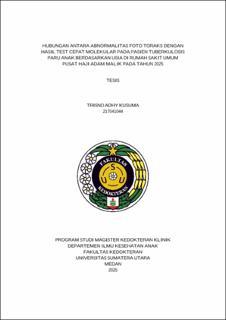Hubungan antara Abnormalitas Foto Toraks dengan Hasil Test Cepat Molekular pada Pasien Tuberkulosis Paru Anak
Association Between Chest Radiograph Findings and Molecular Test in Paediatric Tuberculosis

Date
2025Author
Kusuma, Trisno Adhy
Advisor(s)
Daulay, Rini Savitri
Abdillah, Hafaz Zakky
Metadata
Show full item recordAbstract
Background: Tuberculosis (TB) remains a major global health concern, with children representing a substantial proportion of cases. Diagnosis in paediatric populations is challenging due to non-specific clinical features and limited bacteriological confirmation, making chest radiography and molecular rapid tests essential. Objective: This study aimed to evaluate the association between chest radiographic abnormalities and molecular rapid test results in paediatric pulmonary TB patients at Haji Adam Malik General Hospital. Methods: A retrospective cohort study was conducted from January to May 2025 involving 60 children diagnosed with pulmonary TB. Data collected included demographic characteristics, chest radiograph findings, and molecular rapid test (GeneXpert) results. Radiographs were classified as suggestive or non-suggestive of TB. Diagnostic accuracy was calculated using GeneXpert as the reference standard. Results: Of the 60 patients (46.7% male, mean age 10 years), 48,3% demonstrated abnormal radiographs, most commonly infiltrates (60%) and pleura effusion (23.3%). GeneXpert yielded 30 positive (50%) and 30 negative (50%) results. A significant association was found between radiographic abnormalities and molecular test results (p < 0.001). Diagnostic parameters for radiographs included sensitivity 0%, specificity 3.3%, and accuracy PPV 0% and NPV 3,2%. Conclusion: Chest radiography remains a valuable initial tool in paediatric TB diagnosis but demonstrates limited accuracy compared with molecular testing.
Keywords: Chest radiograph, Diagnostic accuracy, Paediatric tuberculosis, Molecular Rapid Test
